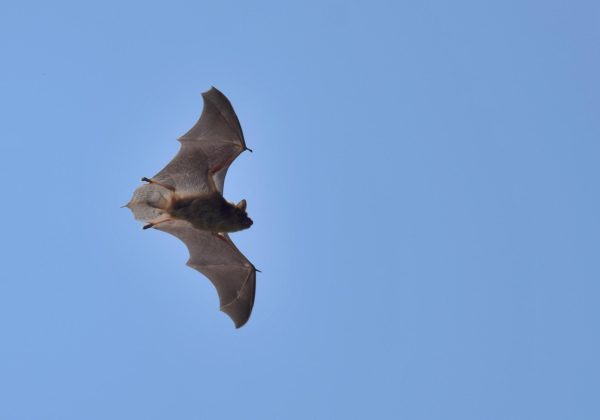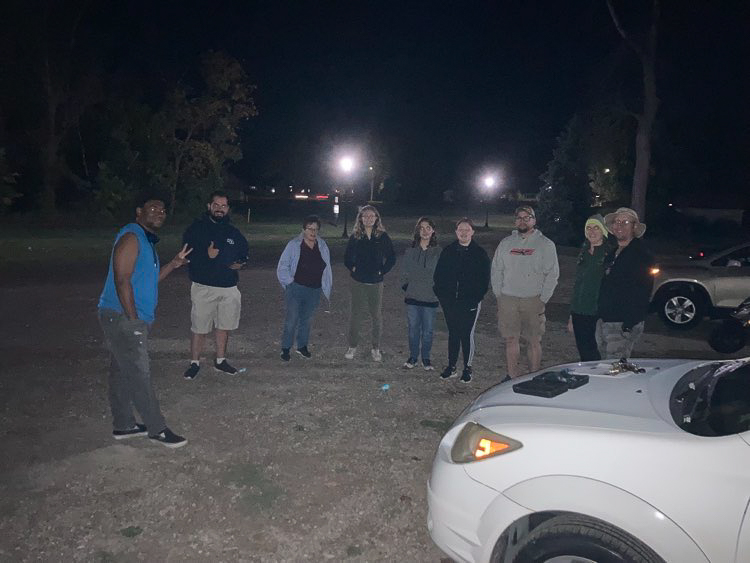Bat fever has hit Winnebago County. And it’s not just because Halloween is almost here.
Thanks to a Green Fund project submitted by the Wildlife Conservation Club (WCC) in spring 2023, UW Oshkosh has been given three bat detectors. These bat detectors pick up the echolocation calls of the eight types of bats found in Wisconsin.
In fact, these bat detectors are essential pieces of conservation equipment, and are currently being used in the university’s first-ever bat monitoring program. The program was started in September by biology and environmental studies professor Shannon Davis-Foust and UWO student Willem Flaugher, a music education major.
For Davis-Foust, starting this program was a year-long endeavor.
“In summer of 2022, I encountered someone who was doing a bat monitoring program,” said Davis-Foust. “I went to see if there was any data reported for Winnebago County, and found almost none.”
This sparked Davis-Foust’s interest, and she began meeting with members of the WCC about a potential Green Fund project to get bat monitors.
“I found a group of students who were really passionate about it, but then they all graduated, and it sort of fell into my lap,” she said. That’s when Willem reached out, who had previous bat monitoring experience from the Zoological Society of Milwaukee, and together they started the program.

In less than two months, the program has completed three successful public bat walks, both on- and off-campus. The walks usually last about 1-½ hours. During the walks, students are able to test out the new bat detectors and follow a predetermined route in hopes of spotting bats in the area. If a bat is present, its echolocation call is inaudible to the human ear. But the bat detectors utilize ultrasonic microphones to record the bat calls, display the waveform on the screen and lower the pitch of the call so you can hear it though the device. Afterward, students can submit these recordings to the Wisconsin Department of Natural Resources’ Bat Monitoring
Program, which will make a map of the route and the species of bat recorded.
“These walks were amazing,” said Myles Dixon, a multimedia journalism major who attended all three walks. “The highlight of the walks for me was when we were crossing a bridge in Omro, and all of a sudden the bat monitors went crazy. Bats were all over this bridge, and we didn’t even see them. It was just the kind of experience that left you with a new perspective on bats and the world around you.”
The start of such programs is becoming more common throughout the U.S., as bats are facing more and more conservation problems. Throughout the world, the population of bats has declined rapidly, leaving about 50% of the 1,200 bat species endangered.
There are two main causes for bat deaths. The first cause of population decline among bats is a result of a nasty fungal disease called White-Nose Syndrome (WNS), which was first found in Wisconsin in 2014. This fungus tends to grow and thrive in cool, damp and dark places, and infiltrate caves. When bats hibernate in caves for the winter, they become prime targets for the disease.
When the fungus infects a bat, it causes a white powder to grow along a bat’s noswe, causing it to awake from hibernation and spend its saved-up energy. Bats with WNS face a 95% mortality rate, and the little brown bat is the most impacted in Wisconsin; it is now listed as threatened and placed under state protection.
Bat monitoring programs, like the one established in Oshkosh, have shown a devastating drop in the number of little brown bats detected when compared to pre-2014. This is cause for concern, as bats are a major consumer of insects in the U.S.
“The type and number of insects eaten by an insectivore like a Wisconsin bat will depend on the species,” says J. Paul White, a mammal ecologist for the WDNR. “A little brown bat, for example, may consume up to 1,000 mosquito-sized insects in an hour during the summer. We also know that Midwest bats eat many agricultural pests (corn borers, cutworm moths, potato beetles and grasshoppers), which means fewer applications of pesticide. A 2011 Science article … projected that in Wisconsin, the pest-control services of bats save the agricultural industry $658 million to $1.5 billion depending on whether it was a low or high pest year.”
The second cause of bats’ declining population is human predation. Public perception of bats has reached an all-time low as most people see bats as scary when they are just misunderstood.
Too many people believe bats are blood-sucking, rabies-carrying, creatures of death, which couldn’t be further from the truth. For starters, only vampire bats drink blood, almost exclusively from livestock and not humans, and they are found exclusively in Central and South America.
According to Merlin Tuttle, the world’s leading bat ecologist and founder of Bat Conservation International, only about 0.5% of bats carry rabies, which is no different than any other mammal, including the dogs or cats you sleep with at home.
Efforts to change public perception on bats have seen some major victories in the U.S. Nowhere is this more evident than under the Congress Bridge in Austin, Texas, where 1.5 million bats live and that take to the night sky every summer. When these bats were first discovered, the city wanted them to be quickly eradicated.
But bat conservationists stepped in to prevent the mass murder of bats and change public perception. Since then, millions of people have traveled from all over the world to safely view this spectacle generating over $12 million for the city’s economy every year.
It is through programs like UWO’s public bat monitoring walks where public perception of bats have changed. As humans, we are often most afraid of the things that we understand the least. By participating in these walks, people learn some of the science and cool facts that go with bat conservation, and leave with a new appreciation for local wildlife.
“Programs like these support both environmental health and human health. On the environmental side, it’s good to get out there and learn about the species around you and the concerns they face. On the human side, it’s great to have a small group of like-minded people gather and promote community. And those hour-long walks require a lot of energy, too,” Davis-Foust said.
By changing public perception, scientists are able to better protect bats and the places they call home.
To get involved in the fight for bat conservation, join the WDNR’s bat monitoring program at wiatri.net/inventory/bats/. Or, stay tuned for the UWO Bat Monitoring Program to start back up in the spring. For more information on how to use these bat monitors and the student-led research opportunities that they could be used for, contact Davis-Foust at .









